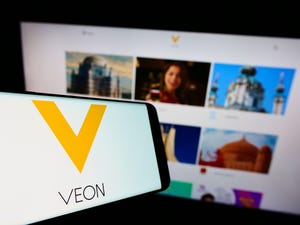Nokia flaunts Google Fiber as 25G PON customer
Google's broadband offshoot will use Nokia's high-speed technology to support residential connections across parts of its US footprint.

PARIS – Network X 2023 – Supercharging residential broadband connections to support 25G PON technology will sound more than excessive to those who doubt the need for speed. But if any company was going to make a noise about a 25G PON investment, it was probably Google Fiber, the Big Tech offshoot that seems to be all about flaunting rapidity. Today, it outs itself as one of a handful of companies now using Nokia's 25G PON technology to hook up ordinary homes.
If it is not quite the first, it is "certainly the most significant," said Bassam El-Zakhem, Nokia's senior vice president of network infrastructure Americas, as the news was revealed during this week's Network X show several thousand miles away in Paris, France. "We have a number of 25G PON deployments, mainly for business services, and there are a few that are residential. This is exciting and it is at a larger scale."
The standard question posed by any naysayer is why the average home would require such high-speed connectivity. Much slower broadband services of up to a gigabit per second seem good enough for an extended bout of Netflix in high definition while the kids are gaming in a separate room. Yet similar arguments were made years ago to defend the use of copper-based broadband connectivity and resist any kind of fiber investment whatsoever. Nokia's rationale is partly about preparing for what El-Zakhem calls "the network of the future," when a wave of unimaginably demanding applications crashes over telco infrastructure.
Then there are the foreseeable ones, including high-definition virtual-reality games hungry for multiple gigabits and low latency. Google Fiber's interest also stems partly from the symmetrical capability of 25G PON, which supports both fast downlink and uplink connections. In trials with a Kansas-based engineering college, that proved critical for climate-change studies where massive amounts of data were uploaded to the cloud, explained Nick Saporito, Google Fiber's product head. "Our mission is to ensure that we are offering speeds suitable for today and into the future," he said.
Human impatience is an additional factor, said El-Zakhem. "If you can transfer a file that used to take a minute in ten seconds, that becomes an expectation." He and his company insist there is a willingness among consumers to pay for speeds and a better experience, although average revenue per user has tended to fall over time as speeds have risen.
Simple change in optics
The nice thing about 25G PON, according to Nokia, is that operators can upgrade without having to rip out existing systems or lay new fiber. All that needs to change is the optical line terminal, a box at the end of the fiber, and the software on top. The caveat is that an operator must have bought line cards featuring Nokia's Quillion chipset when it was rolling out older PON technology. So far, Nokia claims to have shipped more than 1 million ports that are 25G PON-capable. That means there are more than 150 networks that could take advantage of 25G PON through "a simple change in optics," said El-Zakhem.
Still, 25G PON is unlikely to become available to most American homes anytime soon. While Google Fiber does not disclose details of its total customer count, its base of subscribers on 2 Gbit/s, 5 Gbit/s and 8 Gbit/s products today numbers in the tens of thousands, said a spokesperson via email. Across the entire country, Google Fiber's services are currently available in 20 metro areas, although several more are "under construction," said the spokesperson.
Nor is Google Fiber planning a major short-term investment in the Nokia technology, confirmed Saporito. "25G PON deployment is an incremental effort to our existing XGS deployment, so we expect to be able to be responsive to customers," he said, referring to the older standard that supports 10G PON connectivity. "While we don't plan to deploy this broadly across our network yet, we have the technical capability to do it any of our markets."
Meanwhile, there are those in the industry who reject 25G PON outright as a broadband imposter. Nokia rivals including China's Huawei have instead swung behind the even higher-speed 50G PON. Unlike 25G PON, that is an official standard backed by the International Telecommunications Union, they say. Supporters of this technology make the case that XGS-PON will be sufficient for the foreseeable future as a residential broadband technology and that operators are better off saving their money for 50G PON, leapfrogging 25G PON altogether. Calix, a small vendor of broadband products, derides 25G PON and its "multi-source agreement" (MSA) as a Nokia-controlled system.
"First, 25G PON MSA is not an industry standard, and there is nothing multi-source about it," said Andre Viera, Calix's director of access network product marketing, in a blog published in April. "A single, vertically integrated vendor controls the 25G PON MSA main PON component supply – and since the supply chain is a single source, it can be prioritized to meet the vendor's needs over others."
Nokia would obviously reject such criticism, with El-Zakhem pointing out that the MSA now includes various chipset vendors. Intel is on the list, as are numerous big telcos, including AT&T in the US and UK-based Openreach, a subsidiary of telecom incumbent BT. Ciena, a Nokia rival, is also in the club.
Google Fiber's efforts clearly provide some endorsement of 25G PON and could spur rollouts by other companies, which is possibly Google's intention. The unit has long been viewed in the industry as a kind of showcase for what can realistically be done on commercial broadband networks. Google's real interest is in ensuring networks are prepared for the applications it wants to run on them in future, according to many observers.
Commercial activity would clearly help Nokia following a difficult 2023 so far. After growing 15% in 2022, revenues generated from the sale of fixed network products, including fiber-to-the-home connections, fell by the same percentage for the first nine months of this year. Amid high inflation and interest rates, major operators have this year cut spending on network products. As far as Nokia is concerned, 25G PON cannot come fast enough.
Read more about:
Network XAbout the Author(s)
You May Also Like












